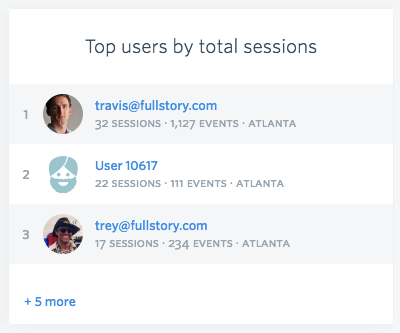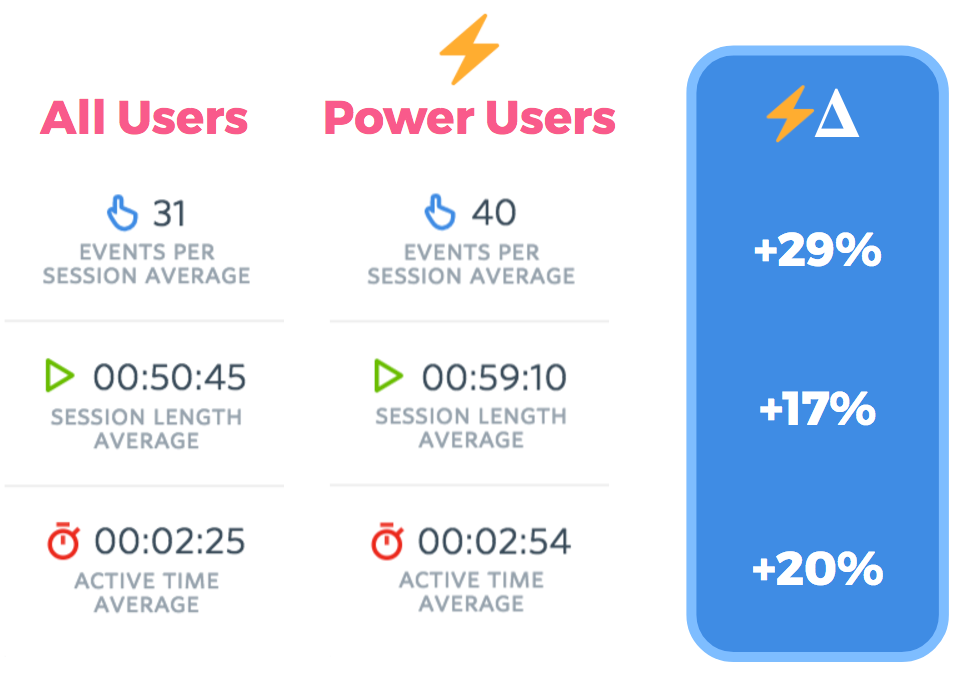If you're like me, there's one app on your phone that you log into first thing every morning. You check it every single day—maybe even every hour—to see what your friends are up to, send messages, or check what's trending in the news.
Maybe it's just to check the weather.
Your app has a similar group of powers users—people who regularly check in, are always looking to discover something new, get the latest info, whatever.
They use every part of your product and know it backwards and forwards. This makes them real-life knowledge databases. Not only do they know more about your product than your average user, they very well may know it better than you.
What makes power users tick? How do regular users turn into power users? If you can understand why power users become so engaged, you can use this insight help the average user, improving the product's value proposition, retention, driving growth, and more.
Start by finding your power users.
Power users by definition use your product all the time.
Because they use your product so frequently, they understand what it's supposed to do for them. They know where to find features and how to adapt them to their specific needs. All of this work and patience makes power users valuable resources not only as long-lived customers, but as reservoirs of knowledge.
Of course, before you can learn from them, you have to know who they are. Below are common ways to identify your power users:
They're "regulars"—repeat users. One of your core metrics is probably DAU. Power users are usually the ones with the most visits under their belt. It's easy to spot regulars in Fullstory (more on that below).
They're vocal and share insights and feedback regularly. For example, they may reach out on social media or forums to talk about your product, offer ideas for new features, or share bugs they've encountered. Twitter, Facebook, LinkedIn, Quora—all of these places are likely to contain public chatter. Google around and take notes on your findings. They are also likely to reach out over your support channels with ideas, feedback, etc.
They're influential. Power users leave frequent, well thought-out comments about your product and have backgrounds that give their comments credibility. Other users are more likely to listen to them and trust what they have to say.
They're active early adopters. Launching MVPs is the norm these days. Power users are the ones who'll not only download a new app just because it's there, but use it consistently.
While there's much to learn about power users "in the wild"—when they're talking about your product to others—the most surefire way to find them and learn from them is through observing how they use your site or app.
That's where Fullstory search and session replay come in.
Identifying your power users in Fullstory.
There are many ways to identify your power users in Fullstory; however, we have a couple suggestions to get you started.
The Top Users list card.
The "came with the frame" solution is to login to Fullstory and scroll down below your list of recent sessions and find the . This shows you top users based on total sessions logged. The list gives you a snapshot of who's most active in your product.

You can refine the Top Users list through filtering your sessions by whatever additional criteria you like.[1] This list is a great place to start your Top Users research. If there are specific identified users (e.g. you are using fs.identify) you find particularly noteworthy, write down their ID. You could create a segment in Fullstory based off these IDs for future reference.
Create a Power Users segment.
The second option is to create a search in Fullstory for your users who have reached a certain threshold of activity. For example, at Fullstory, we have a "Power Users" segment. The search criteria for this segment are simple:
Show me all the users with greater than 100 sessions.
Exclude any users with @fullstory email addresses.
Exclude any users with our IP address.
It looks like this:
If you just created that segment, go ahead and save it!
Having created a Power Users segment in Fullstory, you'll immediately get some juicy stats on them. For example, a cursory look at our Power Users segment in contrast to "Everyone" tells us that our set of "Power Users" represent 4% of our total but 40% of sessions. Wow.
When we run some quick numbers on the Average User Session stats card (read more about that here), we further validate that our power users just do more all around:
Pretty cool, right? But this is just the beginning of what we can learn about power users, and now that you've identified them, you're ready to take the next step.
Learn from them!
Power users reveal the path to your product's value.
Power users put in the time to climb the learning curve of your product. As a result, they know how to navigate your product efficiently. What's more, they are willing to dig around, tinker, and experiment to learn more. There is a very good chance they know your product in a way that you—on the inside of the product—may never quite understand.
You can learn a lot from power users.
Once you identify them, spend some time watching what your top users are doing—using session replay. Think of their interactions as well-worn desire paths that imply intention and purpose. Getting an understanding of these paths will create opportunities. So take notes on their behavior and pay attention to things like:
What do they do first when logging in? The details matter. Remember: your top users are going to be more efficient at navigating your product, so there is very likely a clear purpose in their behavior.
What features do they use the most? If there's a specific feature you want to track interaction with, you could creatively search in Fullstory for interactions with that part of your product and see if any of your Top Users are taking advantage of it.
How long is their typical session? Are they typically in and out over and over again? Or do they tend to have marathon sessions?
Are there common patterns to their sessions? We are creatures of habit—power users are no different.
What features are they not using? We may be in love with our latest snazzy feature, but are the power users actually using it? What features are they not using?
What is the Job to Be Done? Try and tease out what it is—the task—they're looking to accomplish. What is the?
You might be surprised by what you find, but you can take what you learn from your research here and optimize which features to emphasize during onboarding—the goal is to take that value and make it accessible to all of your users.
If you can "pave the path" for all your users and help them extract more value out of your product, your product will be all the more successful.
Caveat!
An important caveat: your power users are a special group of users who are likely the kind of people who always do more when it comes to how they use any given site or app. They have a temperament and a tolerance that your average user may not possess. Therefore, while you're observing power users' behaviors, it's important to remember not to take everything they suggest at face value. They may have a lot of feedback to offer, but they want you to build a product that meets their needs, which may not be the needs of your whole customer base.
The last thing you want is a product they love but average users don't understand.
You still want to help the power users as much as you can, so if there's a feature that your power users are begging for, consider if you could build it with enough flexibility to make it useful for average users and power users.
Give your users the power of appreciation!
Not only are your power users treasure troves of knowledge about your product, they're also hugely invested in what you've built. They may even feel that your product is a part of their identity.
For example, have you ever talked to someone who a master at Excel? If you haven't, find one. Then, pour yourself a cup of tea, find a nice couch, and get them talking about how they use hotkeys, alt+ menu shortcuts, pivot tables, INDEX functions, and on and on. You'll soon be lulled to sleep as they tell you about how to Paste Special ➡ Values.
Commence power nap.
Give your power users something back for their hard work. Recognize their dedication to your product. Incentivize your more average users to become power users. Here are a few suggestions to get you started:
Get testimonials from power users and share them with all of your users via email or social media. Rather than hearing how great your product is from you, which is a lot like hearing a parent glow over their children, let your power users do the talking.
Share their tweets. Ask power users to share their stories. They'll be happy to share and your other users will benefit from hearing their knowledge.Send personalized messages when new users hit certain milestones. Ever considered reaching out directly to your identified power users? "Hey, we appreciate your dedication to our product! We wanted to show that appreciation by shooting you some swag if you were interested."
Since you've already identified your power users (above) using Fullstory, if you have their contact information as part of your user identification, the hard work is already done. Simply export a list, craft an email, and show some appreciation.Create in-app messaging that rewards power users. "Achievement unlocked." Who doesn't like being recognized? Who doesn't like getting a quick high-✋ when you did something cool? Little rewards work, so why not build them into your product?
I have the power!
As you gain fresh insight from your data, it opens the door to new questions. As you have new questions, you need to update your instrumentation and analysis. Saying the process is “done” is saying you understand every thing there is to know about your users, product, and channels. -Brian Balfour
Keeping tabs on your power users is critical—both from a learning standpoint and also by knowing when your power users may be getting frustrated. Just as much as power users are fountains of user-driven product knowledge, they can also be canaries in the coal mine—if you see them losing interest, figure out what's wrong ASAP. Work with your power users so that they always see your product as the answer to their needs.
Now go appreciate your power users and empower everyone else!






